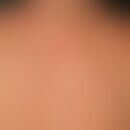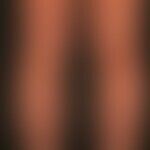Synonym(s)
HistoryThis section has been translated automatically.
DefinitionThis section has been translated automatically.
Very superficial, large-area, non-sclerosing variant of circumscript scleroderma; belonging to type I (plaque type) of circumscript scleroderma.
You might also be interested in
Occurrence/EpidemiologyThis section has been translated automatically.
More frequent occurrence in Europe than in North America (?).
EtiopathogenesisThis section has been translated automatically.
It is discussed whether an infection with Borrelia burgdorferi plays a pathogenetic role. In a study with 17 volunteers, IgG antibodies against Borrelia burgdorferi could be detected in 53% of the cases (in these cases the question of differentiation from acrodermatitis chronica atrophicans arises).
ManifestationThis section has been translated automatically.
Women are more frequently affected than men. The age of the disease is between 10-30 years.
LocalizationThis section has been translated automatically.
Lower extremities (60% of patients), upper extremity, trunk, especially back. Capillitium always remains free in this subtype of circumscribed scleroderma.
ClinicThis section has been translated automatically.
Mostly multiple, disseminated, symmetrical but also asymmetrical or unilateral, small and large spots, up to 20 cm in size or larger, bizarrely bordered, bluish-brown or violet, less frequently skin-colored or slightly depigmented, surface level or somewhat sunken spots (patches) / atrophy, with thinned, non-scalying skin which wrinkles when pushed together. In individual cases the lesions are cutaneous mosaics (phylloidal patterns) or follow a segmental pattern. I.A. no complaints.
Three subgroups are described:
- Scléroderma atrophique d'emblée
- sclérodermia minima
- Sclérodermie lilacée non indurée.
HistologyThis section has been translated automatically.
Initially, diffuse sparse lymphohistiocytic infiltrates are found between thickened collagen fiber bundles, also condensed and perivascularly oriented at the cutaneous-subcutaneous border. Rarely, an accompanying eosinophilic component is present. The orthokeratotic epidermis is usually thinned and basally hyperpigmented. Solitary melanophages in the upper dermis. Epidermotropism is always absent. A plasma cellular component is absent (in contrast to a Borrelia infection).
Differential diagnosisThis section has been translated automatically.
Systemic scleroderma: diffuse and non-plaqueform, distinct induration, sign of system sclerosis.
Parapsoriasis en grandes plaques: always signs of pseudoatrophy when the skin is wrinkled, no atrophy of the plaques, sharp-edged limitation, often itching.
Nevus spilus: congenital, smooth non-atrophic spot, bruised dark brown spots.
Mongol stain: congenital, blue-brown colour, no surface atrophy.
Acrodermatitis chronica atrophicans: distinct parchment-like atrophy of the skin, blue-livid colour; serology is diagnostic.
Radiation therapyThis section has been translated automatically.
Internal therapyThis section has been translated automatically.
If the borrelia titer is positive: infusion therapy with penicillin G (see Lyme disease).
In individual cases hydroxychloroquine is said to have helped.
LiteratureThis section has been translated automatically.
- Aberer E et al (1988) Neuroborreliosis in morphea and lichen sclerosus et atrophicus. J Am Acad Dermatol 19: 820-825
- Carter JD et al (2006) Hydroxychloroquine as a treatment for atrophoderma of Pasini and Pierini. Int J Dermatol 45: 1255-1256
- Jacobson L et al (2003) Superficial morphea. J Am Acad Dermatol 49: 323-325
- Handler MZ et al (2012) Congenital idiopathic atrophoderma of Pasini and Pierini. Dermatol Online J 18:4.
- Kang CY et al (2015) Congenital idiopathic atrophoderma of Pasini and Pierini. Int
- J Dermatol 54:e44-46
- Lee Y et al (2011) A Case of Atrophoderma of Pasini and Pierini Associated with Borrelia burgdorferi Infection Successfully Treated with Oral Doxycycline. Ann Dermatol 23:352-356
- Miteva L et al (2006) Unilateral idiopathic atrophoderma of Pasini and Pierini. Int J Dermatol 45:1391-1393
- Pasini A (1923) Atrofodermia idiopatica progressive. G Ital Dermatol 58: 785
- Pierini L, Vivoli D (1936) Atrofodermia progressiva (Pasini). G Ital Dermatol 77: 403-409
- Saleh Z et al (2008) Atrophoderma of Pasini and Pierini: a clinical and histopathological study. J Cutan Pathol 35:1108-1114
- Toledano C et al (2008) Localized scleroderma: a series of 52 patients. Eur J Internal Med 20:331-336
Incoming links (11)
Anetoderma; Atrophodermia; Granulomatous interstitial Dermatitis with arthritis; Hyperpigmentation, circumscribed; Lipodystrophia centrifugalis abdominalis infantilis; Pasini, agostino; Pierini, luis enrique; Scléroderma atrophique d\'emblée; Scleroderma erythematosus circumscripts; Scleroderma minima; ... Show allOutgoing links (12)
Acrodermatitis chronica atrophicans; Borrelia burgdorferi sensu lato; Circumscribed scleroderma; Hydroxychloroquine; Lyme borreliosis; Mongolian spot; Nevus spilus; Parapsoriasis en plaques large; Puva bath therapy; Puva cream therapy; ... Show allDisclaimer
Please ask your physician for a reliable diagnosis. This website is only meant as a reference.



























